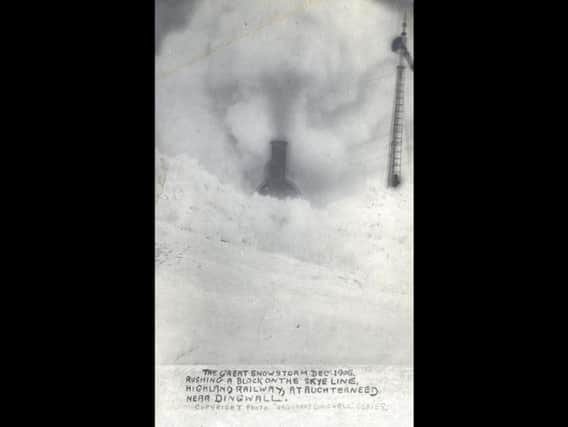Remembering the Christmas snowstorms of 1906: bravery, exhaustion and train passengers trapped for two days


The Christmas snowstorms of 1906 hit when 'railways reigned supreme' with the shock conditions creating 'dramatic blockages' on the Kyle of Lochalsh railway, according to an article by weather expert David McConnell.
Such were the conditions, they had to walk the final four miles or so to the slope at Acheterneed to try and reach the stranded train and its passengers, with the snow six feet deep in parts.
Advertisement
Hide AdAdvertisement
Hide AdHe added: "They persisted in their exertions, but these proved futile amid the tremendous walls of snow, and this train, like the one at Rogie, had to remain stuck for the rest of the day.
"The passengers had spent several hours in the trains in the expectation that they would soon be on the move again, and it was late in the afternoon when they learned that they would not be doing so that night and would have to stay on the trains. "
Passengers stuck on a train at Rogie bedded down in the first-class compartments.
Meanwhile, some of those stuck on the train at Achterneed decided instead to make their way to nearby crofts or crosscountry to Strathpeffer in the hope of finding a bed for the night.
The railway men carried some women and girls who just could not make their way through the fields of snow. Some ended up sleeping in a nearby electric power station, McConnell wrote.
On the morning of Friday, December 28, passengers on the train at Rogie started to make the three-mile journey to the village of Garve.
However, the conditions started to take their toll on many.
"Some of them were so quickly overcome with exhaustion on struggling through the deep drifts, as well as having to suffer the extreme cold, that the railway workers had to carry them through the glen to the nearest shepherds' and gamekeepers' houses," McConnell said.
Back at Achterneed, around 70 railwaymen started to battle the now 15ft drifts with shovels. After several hours of strenuous work in freezing conditions, the carriages were freed.
Advertisement
Hide AdAdvertisement
Hide AdThe train at Rogie remained stuck in the snow until 7pm on the Saturday despite a massive effort by rescue parties who were toppled by severity of the drifts several times.
"Finally, on the Saturday evening at 8 o’clock, two special trains left Dingwall for Kyle to convey the traumatised passengers, two and a half days late, to their destinations in the western Highlands," he said.
The Christmas snowstorms took the United Kingdom by surprise, not least because the winter had been untypically mild until then.
In London, the city woke to four to five inches of snow on the morning of December 27.
Indeed, more than half of the British Isles recorded a depth of greater than 5 inches of snow, which came in two storms over the Christmas period, one overnight on the 25th and the other on the 27th and 28th.
The breakdown of communications across Scotland was rarely paralleled, McConnell wrote.
Tragically, the storm created a fatal train accident near Arbroath on the afternoon of Friday 28th, the anniversary of the collapse of the railway bridge over the River Tay in 1879.
The accident near Arbroath was the worst recorded since the tragedy near Dundee, 27 years earlier.
Advertisement
Hide AdAdvertisement
Hide AdMore than 20 people died when the Edinburgh to Aberdeen express 'collided violently' with a stationary local train in the 'blinding snow'.
The storm caused several other deaths around the country, including a bakery delivery man who was discovered dead with his horse and sledge in a drift near Aboyne.
At nearby Dess, a shepherd was found frozen to death and a woman's body was found buried in snow at Portlethen station, south of Aberdeen.
